Life’s perfect view lies in the altitude of nature. Nepal, the land of peaks falls in the lap of Himalayas.
Nepal is also known as the country of elevations due to the huge range of mountains falling in its geographical territory. The country is full of mountain peaks ranging from heights of 5,357 m (Gokyo RI) to extreme highs of 8,848 m (The Mount Everest).
Natural beauties like waterfalls, intense forests, high mountain passes, and river basins also make the country more attractive but it’s the sky-high peaks which attract more visitors to the country. World’s highest mountain peak.
The Mount Everest is situated in Nepal, apart from this, 8 of the 14 highest mountain peaks across the globe which are greater than 8000 m in altitude are present in Nepal.
To summarize this entire country, you can fairly say that Nepal is a country which is full of adventures of climbable and unclimbed peaks for which every year people from all parts of the globe visit and explore.
Listed below are the top 10 Mountains of Nepal:
10. Annapurna II

| Height: | 7,937 meters |
| Location: | Annapurna region |
| First Summited by: | Sherpa Ang Nyima, J. O. M. Roberts, Chris Bonington, and Richard Grant |
Annapurna II is located on the central part of the Himalaya range and is a part of Annapurna Mountain massif.
This peak was first summited in the year 1960 by British/Indian/Nepali expedition team having members namely Sherpa Ang Nyima, J. O. M. Roberts, Chris Bonington, and Richard Grant.
As the name suggests this mountain is the second highest peak of the Annapurna Himalayan range. The view of this peak can be seen from Pokhara valley.
Due to the steep nature and dangerous descent of this mountain, there have been only a few summit attempts for this peak.
9. Gyachung Kang – Mountain between Mountains
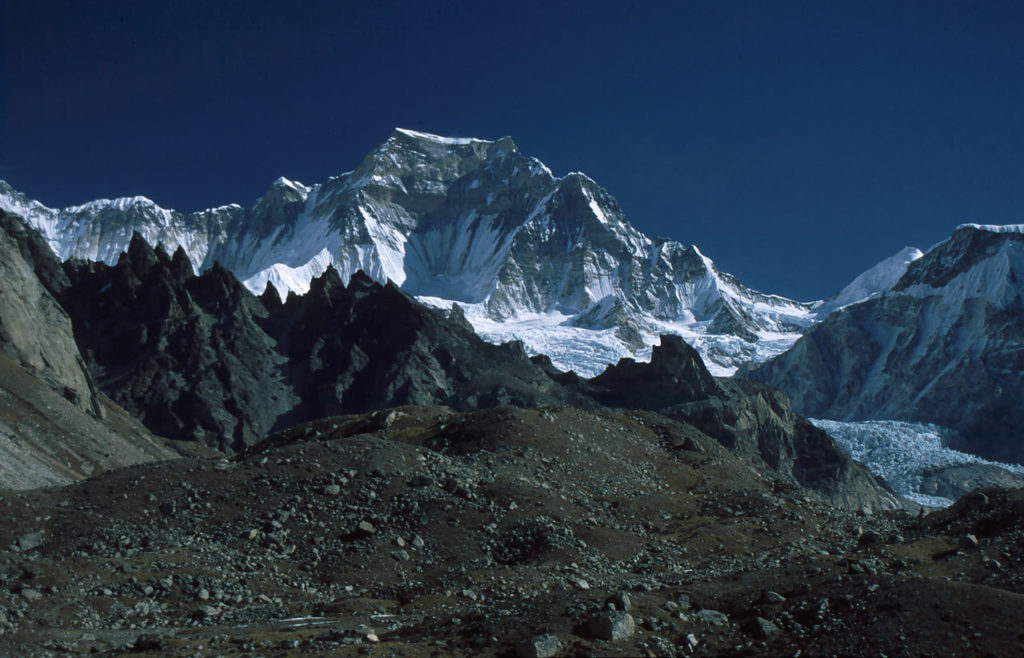
| Height: | 7,957 meters |
| Location: | Khumbu region |
| First Summited by: | Yukihiko Kato, Pasang Phutar Sherpa, and Kiyoto Sakaizawa |
Gyachung Kang lies in the central location of the two other highest peaks of Nepal namely Mount Everest and Mount Cho Oyu. At the global level, this peak is considered to be the fifteenth highest peak.
It was first summited in the year 1964, by Japanese expedition team namely Yukihiko Kato, Pasang Phutar Sherpa, and Kiyoto Sakaizawa.
This is the tallest mountain lying between Cho Oyu and Mount Everest and its peaks are mostly covered with snow and rock towers. Gyachung Kang is a glaciated peak with an ample amount of natural beauty.
8. Annapurna I – Goddess of Harvest

| Height: | 8,091 meters |
| Location: | Annapurna region |
| First Summited by: | Louis Lachenal, Maurice Herzog and Lionel Terray |
Annapurna I is the part of Annapurna mountain massif and is situated in central Nepal. It comprises of a peak greater than 8,000 meters, 13 peaks more than 7,000 meters and 16 more than 6,000 meters.
The name Annapurna is derived from Sanskrit which means “Full of Food” and hence this mountain is often referred to as a symbol of good fortune and wealth.
This trekking route which leads to the view of Annpurna I is considered to be as one of the busiest mountain peaks for trekking due to its beauty and easy terrains which attract several visitors every year. This mountain was first summited by Louis Lachenal, Maurice Herzog and Lionel Terray.
7. Manaslu – Mountains of Spirits
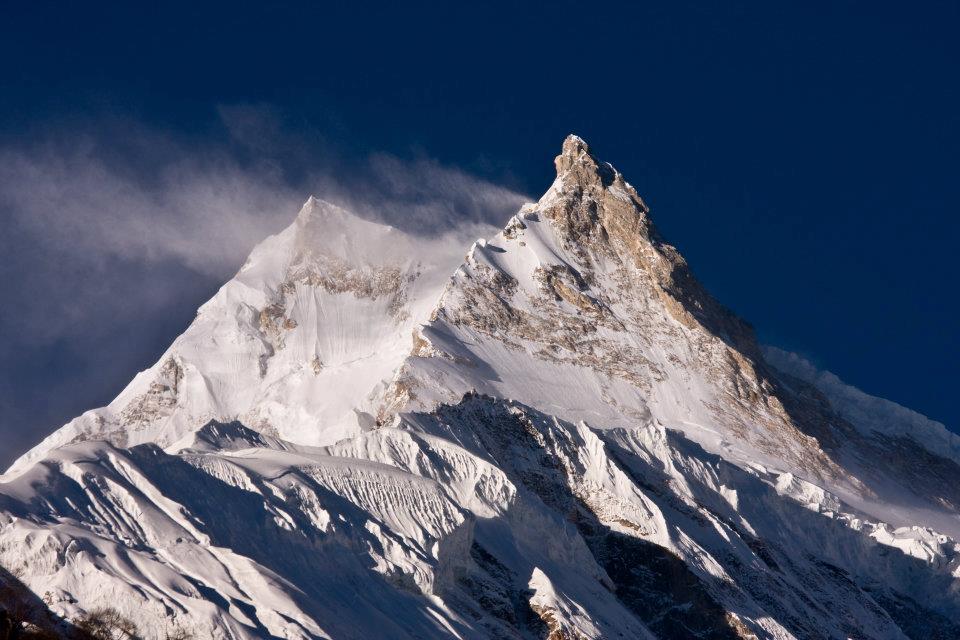
| Height: | 8,156 meters |
| Location: | Gorkha District |
| First Summited by: | Gyalen Norbu, Artur Hajzer and Toshio Imanishi |
Manaslu Mountain is located 64 km east of Annapurna I and is a part of Mansiri Himalayan massif. It is the eighth highest peak in the world. The name of the mountain is derived from the Sanskrit word “Manasa” which means “intellect”.
This peak was first summited in the year 1956, by Japanese mountaineers namely Gyalen Norbu, Artur Hajzer and Toshio Imanishi.
Trekking was not permitted in this region earlier by the Nepali Government but in 1991 the government removed this restriction which attracted furthermore visitors to this site.
6. Dhaulagiri I – Easiest to Conquer
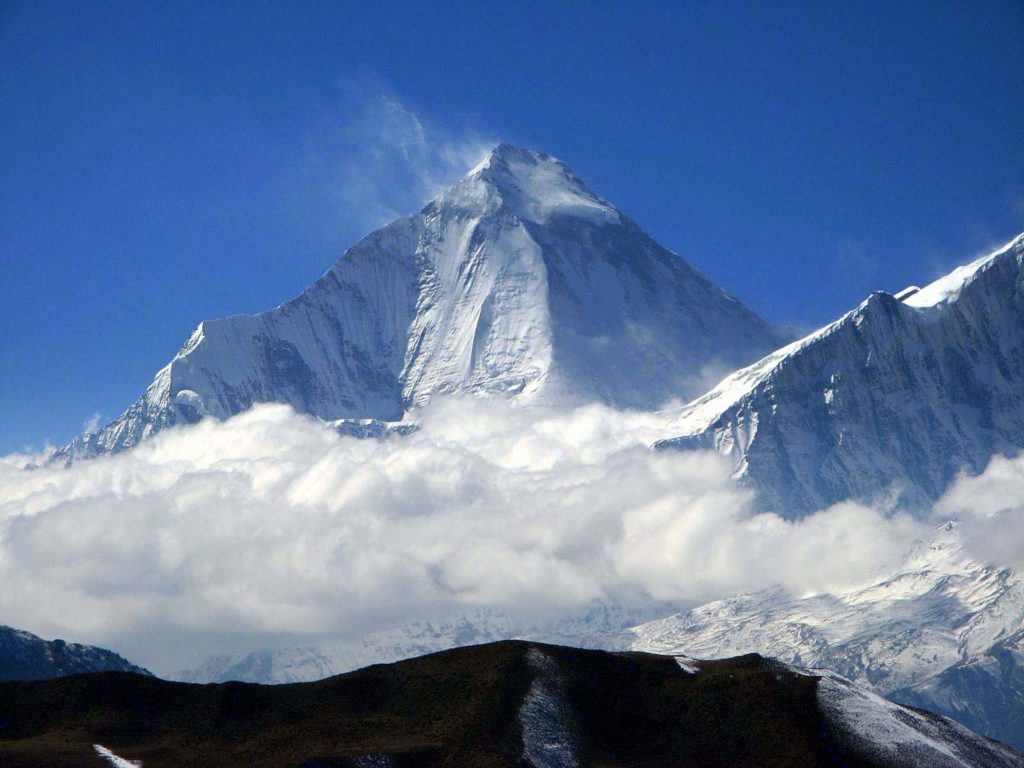
| Height: | 8,167 meters |
| Location: | Annapurna region |
| First Summited by: | A. Schelbert, Nawang Dorje, E. Forrer, Nyima Dorje, and Kurt Diemberger |
Dhaulagiri I is located entirely in Nepal as an extension of Kali Gandaki river which flows to Bheri. The name of the mountain is derived from Sanskrit words “Dhwala” and “Giri” which means “dazzling” and “mountain” respectively. It is also the highest point of the Gandaki river basin.
On a beautiful sunny day with no clouds covering the sky, this peak becomes quite clearly visible from Indian state Bihar.
In the year 1960, this peak was first summited by Swiss mountaineers- A. Schelbert, Nawang Dorje, E. Forrer, Nyima Dorje, and Kurt Diemberger. This sky-high peak is assumed to be least crowded and hence preferable for those mountaineers who like less crowded regions.
5. Cho Oyu – Mighty Head of Goddess
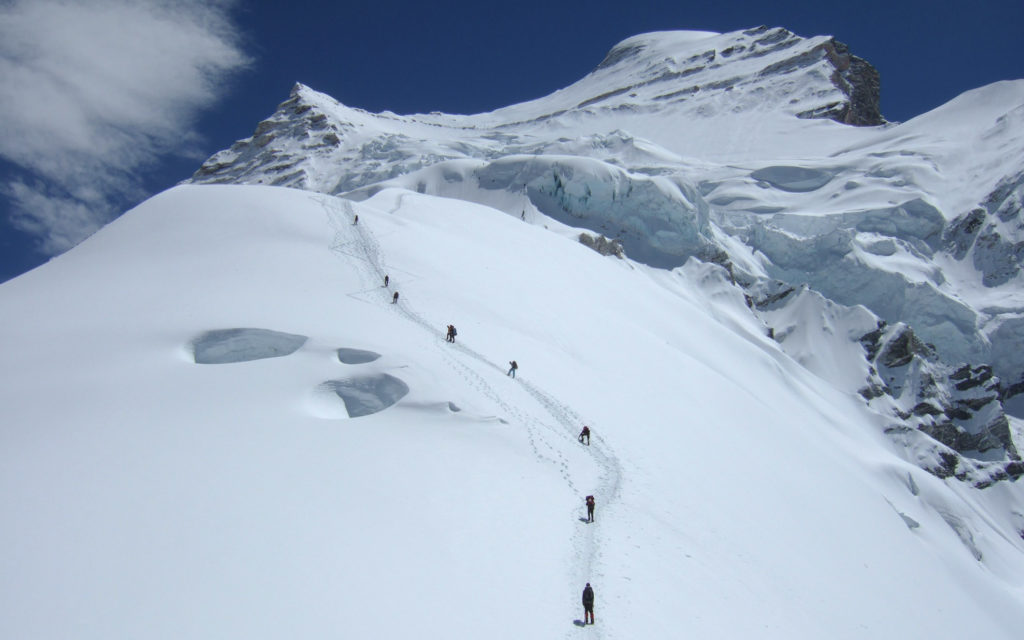
| Height: | 8,188 meters |
| Location: | Khumbu region |
| First Summited by: | Joseph Jochler, Herbert Tichy and Pasang Dawa Lama |
Cho Oyu is situated 20 km west of Everest and it is the sixth highest peak situated between China and Nepal border.
The word Cho Oyu is a Tibetan word which means ‘Turquoise Goddess’. This mountain lies in the part of Mahalangur Himalayan range and the most interesting fact says it’s the easiest mountain to climb in 8,000 meters.
In the year 1954, Oct 19th, it was first summited by an Austrian expedition team of Joseph Jochler, Sherpa Pasang Dawang, and Herbert Tichy.
Being the easiest peak to climb the Cho Oyu gained the same level of popularity as Everest and holds the record most numbers of ascends. Most of the times, this peak is climbed by the western face of Tibet and rarely from Nepal.
4. Makalu – The Himalayan Pyramid
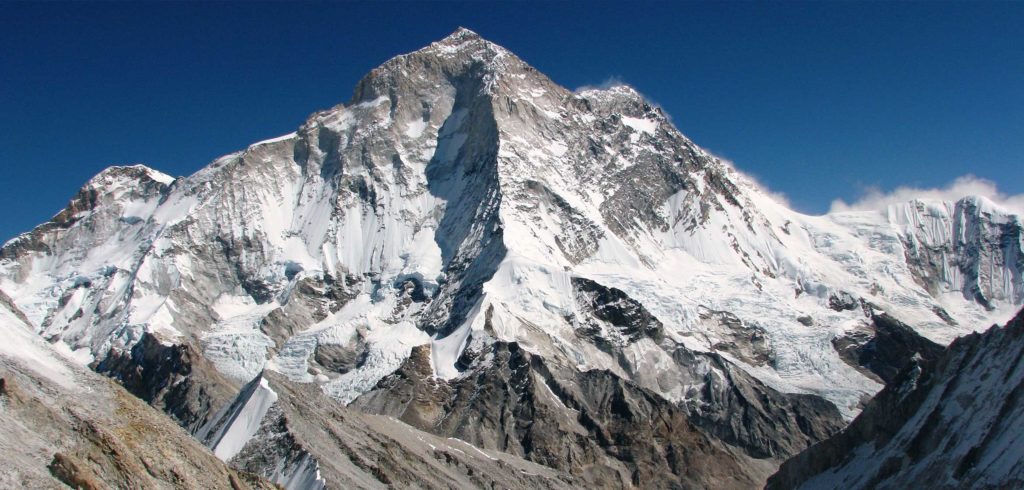
| Height: | 8,481 meters |
| Location: | Khumbu region |
| First Summited by: | Jean Couzy and Lionel Terray |
Mount Makalu is the fifth highest peak of the world which is located 22km south-east of Everest. This mountain is in between Nepal and China border.
The shape of Mount Makalu is something similar to a four-sided pyramid which comprises of snow and ice primarily. The name Makalu is derived from Sanskrit word “Maha Kala” and this mountain is named after Lord Shiva. Makalu has two subsidiary peaks as well which are Chomo Lonzo and Kangchungtse.
This mountain was first summited in the year 1955, on May 15th by French mountaineers Lionel Terray and Jean Couzy. Due to its steep structure, Makalu is considered to be one of the most difficult peaks to conquer by mountaineers.
The most attractive reason to visit Makalu is the Makalu-Barun Valley which is beautified with white rivers and glaciers. The same Barun Valley is also a sanctuary for animals.
3. Lhotse – The South Peak
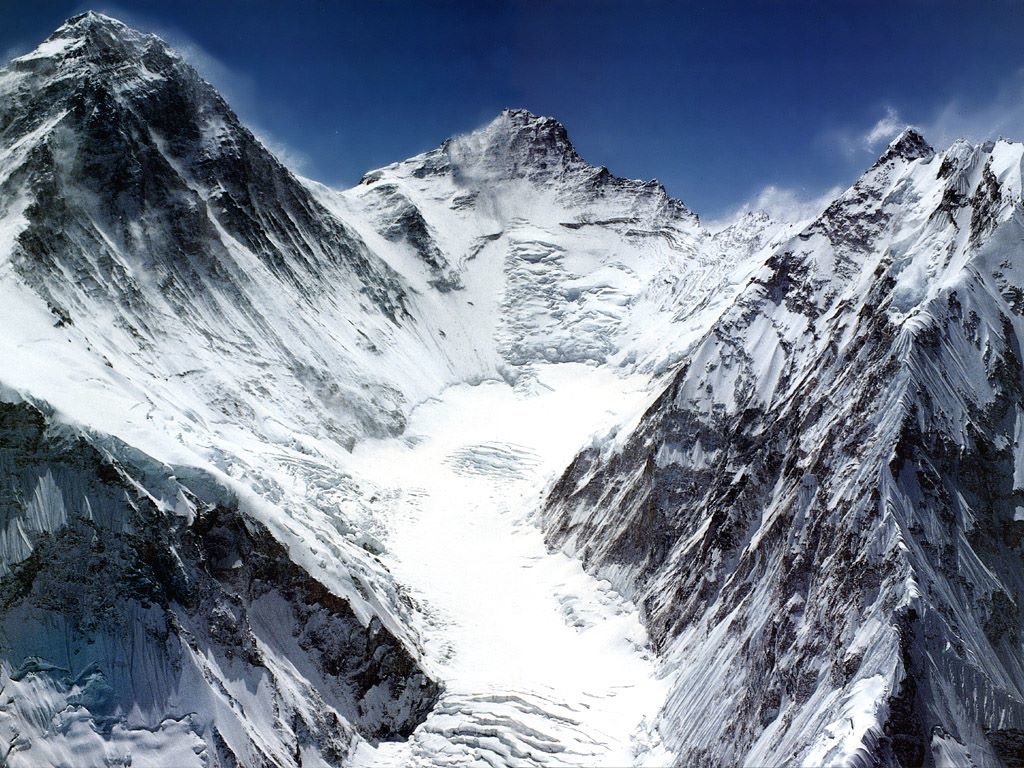
| Height: | 8,516 meters |
| Location: | Khumbu region |
| First Summited by: | Fritz Luchsinger and Ernst Reiss |
Lhotse a Tibetan name meaning ‘the South peak’ is the fourth highest peak in the world. It is a part of Mount Everest massif.
This mountain mainly comprises of three peaks which are – the main summit (8,516 m), the Lhotse East (8,414 m) and the Lhotse Shar (8,383 m). While talking about a proper alternative to Mount Everest, Lhotse is the one which strikes the mind due to sharing the same route as Mount Everest.
This peak which lies on the border of Khumbu region and Tibet was first summited by Swiss mountaineers namely Ernst Reiss and Fritz Luchsinger in the year 1956.
Lhotse Shar was first summited in the year 1970 by Austrian mountaineers namely Sepp Mayerl and Rolf Walter. But, Lhotse middle remained unclimbed until 2001, it was first summited by Russian mountaineers.
2. Kanchenjunga – The Five Repositories of the Snow

| Height: | 8,586 meters |
| Location: | Taplejung District |
| First Summited by: | oe Brown and Gorge Band |
Kanchenjunga is situated 125 km south-east of Everest and is the third highest peak in the world. The entire mountain does not lie in Nepal and hence is partly shared by India (Sikkim).
Due to its remote locations, the peaks are idealized as sacred and holy by the people of both countries. Kanchenjunga holds as many as five peaks which are also known as ‘five treasures of snow’ by the people.
The belief of local people claims that the mountain holds as many as five typical treasures which are salt, gold, turquoise, sacred scriptures, invincible armor, and medicines.
The word Kanchenjunga comes from Tibet which means ‘five repositories of snow’. In the year 1995, 25th May Kanchenjunga was first climbed by two British climbers namely Joe Brown and Gorge Band.
People nearby (Limbu community) worship the Goddess Yuma Sammang which according to their belief lies in the arm of Kanchenjunga conservation area.
Apart from this people also have demonic beliefs as well and hence the myth sounds as “the Kanchenjunga demon” where they believe that the mountain is home to Dzo-nga a type of rakshasa.
As the mountain is shared by two countries India and Nepal, hence there are four possible routes to climb it of which three lies in Nepal while one of the routes exists in India.
Another interesting fact about Kanchenjunga is its adventure is penned down by Raymond Benson for his book ‘High Time to Kill’ which a part of James Bond’s adventure in Kanchenjunga.
1. Mount Everest – Highest Mountain Peak on the Planet

| Height: | 8,848 meters |
| Location: | Solukhumbu District |
| First Summited by: | Tenzing Norgay Sherpa and Sir Edmund Hillary |
The Mount Everest named after Sir Gorge Everest lies in the Khumbu region of Nepal. This sky-high peak is a part of the Mahalangur Himalayan range.
It is also called as “Sagarmatha” in Nepali (Nepal’s official language) as it is the highest mountain peak in the world. The literal meaning of word Sagarmatha is “the Head of the Sky”.
Mount Everest has two possible routes for climbing, one existing in Nepal while the other one from Tibet where it is called as “Chomolungma”.
In the year 1953, a mountaineer namely Sir Edmund Hillary from New Zealand and a Sherpa namely Tenzing Norgay Sherpa from Nepal took this tough challenge to reach the top spot on the Everest.
Mount Everest is also a great attraction for tourism and adventure. The trekking journey after being commercialization has given rise to the global popularity of Everest Base Camp Trek.
The region of Mount Everest is mainly comprised of the Sherpa community, who are known as the best climbers of the mountain. The average age of Everest is claimed to be 60 million years where the supersonic wind streams are freezing and approaching at a speed of nearly 93.3 Kmph.
Final Conclusion: These are the top 10 mountains of Nepal which offer nature’s beautiful sight. Some of them are suitable for climbing and trekking while some are not quite safe to do so. Nepal’s main attraction and tourism lie in these natural giants.